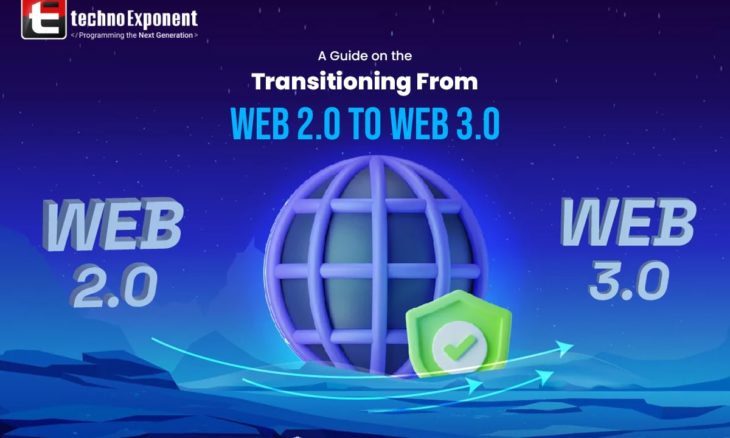
We are living in a rapidly evolving technological and competitive world, and staying up-to-date is necessary for surviving properly. One of the most significant advancements in recent years is the advent of Web 3, making the transition from Web 2.0 to Web 3.0 an imperative. Web 3.0 has solidified itself as the industry standard, by offering innovative technological solutions followed by widespread acceptance. Nowadays, almost all small-scale or big-scale businesses are recognizing the advantages of migrating from Web 2.0 to Web 3.0.
According to the users, web 3.0 offers superior safety and transparency as it consists of decentralized architecture. This has led individuals and organizations to collaborate on the development of a new generation of applications that are more open and user-friendly using Web 3.0 technology. If you’re contemplating how to make the move from Web 2.0 to Web 3.0, this blog is for you. In the following sections, we will guide you through a step-by-step procedure for successfully transitioning from Web 2 to Web 3.
About Web 3.0:
Web 3.0, or Web 3 has introduced a decentralized network where users can have firm control over their data. Also known as the Semantic Web, it empowers individuals to create, share, and connect through content analysis and search, focusing on word comprehension over numerals and keywords.
Web 3.0 is highly intelligent and responsive, driven by Machine Learning and Artificial Intelligence. One can have internet access without having some specific devices and the users can choose to interact publicly or privately while safeguarding their privacy.
Understanding these core distinctions is a vital first step in your journey toward embracing the innovations and opportunities that Web 3.0 brings to the digital landscape. Now, let’s explore how to navigate the transition effectively.
The Transition:
The Internet has evolved significantly since its public inception, and today, we stand at the threshold of a new era known as Web 3.0. This Web 3.0 represents a visionary shift, integrating the latest technologies like artificial intelligence, machine learning, blockchain, and virtual reality/augmented reality, promising a more intelligent, decentralized, and interactive digital landscape.
Web 3.0, referred to as the “semantic web” or the next phase of the Internet, aspires to empower individuals, offering them greater online experiences. In stark contrast to the current “centralized” web, dominated by a few major corporations controlling online infrastructure and user data, Web 3.0 champions decentralization.
By using the power of blockchain and decentralized protocols, Web 3.0 has empowered users to store and manage their data, as a result, they do not have to trust vulnerable third-party servers and avoid cyberattacks. These heightened security measures make it considerably more challenging for hackers to access sensitive information, providing users with control over their data usage and sharing.
Web 3.0 platforms pave the way for decentralized applications (dApps), free from centralized servers and intermediaries. Thus, developers and designers can explore a new realm of possibilities, creating applications that are more scalable, secure, and efficient than their centralized counterparts.
Artificial intelligence (AI) takes center stage in personalizing internet experiences, tailoring search results and content recommendations to individual preferences. This enhances the overall online experience, making it more relevant and engaging for users.
The influence of virtual reality (VR) and augmented reality (AR) on Web 3.0 is profound. These technologies immerse users in the digital realm, offering a truly interactive experience. Users can access virtual environments, potentially revolutionizing fields like virtual conferences, online commerce, and even virtual travel.
Augmented reality overlays virtual information onto the real world, opening up new horizons for navigation, product presentation, gaming, and various enterprise applications.
Web 3.0 has particularly transformative potential in finance. Decentralized finance (DeFi) is a burgeoning industry leveraging blockchain to provide financial services without traditional intermediaries. DeFi apps, such as decentralized exchanges, are gaining traction and promise continued growth.
In its early developmental stages, Web 3.0 holds immense promise, poised to reshape the Internet’s utility and create fresh opportunities for individuals and businesses alike. As it continues to evolve, we are entering an exciting era of digital transformation.
The Internet’s evolution has expanded its capabilities and revolutionized how we interact and access information online. The infusion of AI, machine learning, and blockchain into the web has the potential to redefine not only our online interactions but also how we engage with each other in the digital landscape.
Techno Exponent – The Web 3.0 Expert
Techno Exponent is your go-to partner for unlocking the potential of Web 3.0. With expertise in Blockchain, AWS development, and Machine Learning, they empower businesses to thrive in the digital age. Their Blockchain solutions ensure secure and transparent transactions, while AWS development harnesses the power of cloud computing for scalability. Machine Learning capabilities enable data-driven insights and automation. Techno Exponent’s services pave the way for businesses to embrace the decentralized, intelligent, and interconnected landscape of Web 3.0, positioning them for success in the future of the digital realm.
 +44 141 628 8980
+44 141 628 8980
 (786) 269-2247
(786) 269-2247
 +61 872007153
+61 872007153
 +91 8900027268 (Sales only)
+91 8900027268 (Sales only)








